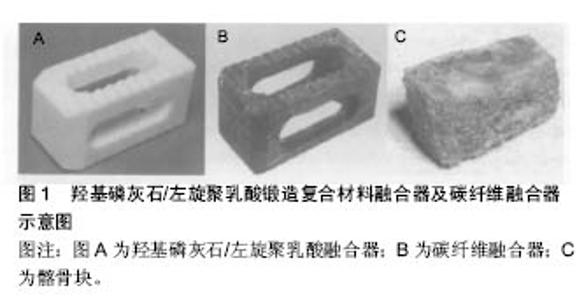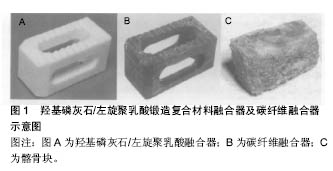Chinese Journal of Tissue Engineering Research ›› 2017, Vol. 21 ›› Issue (2): 315-321.doi: 10.3969/j.issn.2095-4344.2017.02.027
Previous Articles Next Articles
Research progress of interbody fusion cage and its materials
- Affiliated Hospital of Qingdao University, Qingdao 266000, Shandong Province, China
-
Received:2016-10-23Online:2017-01-18Published:2017-02-27 -
About author:Zhao Bo-ran, Studying for master’s degree, Physician, Affiliated Hospital of Qingdao University, Qingdao 266000, Shandong Province, China
CLC Number:
Cite this article
Zhao Bo-ran, Zheng Xiu-jun, Ma Jin-rong.
share this article

2.1 金属融合器 2.1.1 BAK融合器 金属融合器是科学家们最先研制出的并且最早应用于临床的椎间融合器。Bagby等于1979年首次将不锈钢材料的中空带孔的柱状体(里面塞满咬除的碎骨块)用于马颈椎椎间融合术中,并取得了良好的疗效,称之为Bagby融合器[1]。1983年Kuslich等[2]又成功研制了BAK融合器,并将其用于人的腰椎椎间融合术中。BAK融合器的材料是钛合金,是一种中空圆柱状金属椎间融合器,融合器的上下表面都有许多大孔,将融合器植入椎间隙中,其表面的螺纹可以与上下终板进行咬合从而达到自稳的效果。椎体的前后纵韧带以及纤维环因为被融合器撑开而处于一种张力状态,产生了“撑开-压缩张力带”效应[3],从而加强了融合器稳定的效果。1988年,Bagby成功的将BAK融合器用于治疗腰椎间盘突出症的患者,临床效果良好。 2.1.2 螺纹状椎体融合器(Threaded fusion cage Ray-TFC) 20世纪80年代末期,Ray等对最初的Bagby融合器进行改造,在融合器表面增添了螺纹结构,制成了Ray-TFC融合器,使其机械强度和稳定度都得到了增强[4]。进行腰椎融合术时,经前路或者后路放入2枚Ray-TFC融合器,通过融合器两端的螺纹结构将上下2个椎体牢牢地固定住,术中可以在融合器中根据情况放入自体骨、异体骨或者合成骨,有利于椎间融合。 2.1.3 LT(Lumber Tapered)融合器 LT 融合器前高后低,呈薄壁锥形,这样既可以扩大其接触面积又有利于恢复脊柱前凸。与之前的金属融合器相比,它的侧壁有所缩短,有利于通过影像学方法来评估融合器内外新骨生成的情况。Williams等[5]将骨形态发生蛋白2填塞到LT融合器中用于单节段腰椎融合术中,随访6年,影像学证实椎间隙稳定,有新骨生长,融合效果令人满意,患者的症状得到了改善。 2.1.4 钛网融合器 钛网融合器是一种垂直放置的钛制网状结构,手术过程中可以根据需要进行裁剪,中间还可以填入自体骨或者异体骨有利于融合。钛网融合器可以提供椎体前柱的稳定性,恢复椎间隙的高度,常用于因感染、结核、肿瘤等需要椎体次全切除,保持椎体的稳定性。 经过实验研究发现,钛金属与其他金属相比具有很强的抗疲劳性和耐腐蚀性。钛金属还具有较好的生物相容性,将钛金属植入到动物体内,与其他金属相比钛金属的排斥反应较小。随着临床的应用,钛金属融合器的缺点逐渐显露出来:①在X射线片上不能观察到骨融合的情况;②钛合金弹性模量较高,术后容易出现临近椎体的下沉及应力遮挡等并发症;③钛金属价格较昂贵,不利于临床的应用。 2.1.5 其他金属融合器 金属融合器具有较高的硬度及抗断裂韧性的特点,不锈钢及钴金属具有足够的强度,但它的弹性模量较高,植入人体后会出现应力遮挡作用,临床应用较少;相比较,镁金属安全性较高,可随尿液排出体外,弹性模量较低,能有效地降低应力遮挡作用。但是镁合金降解过快,无法提供足够的力学支撑。目前研究在镁金属表面改性有助于缓解它的降解并提高生物相容性[6]。 2.2 碳纤维椎间融合器 Brantigan等[7]于1991年成功研制出了应用于腰椎椎间融合的碳纤维椎间融合器。碳纤维材料具有较好的生物相容性,其弹性模量接近骨组织,生物力学性能与骨皮质相近,有较小的应力遮挡作用,能有效地恢复脊柱的生理弯曲。融合器的上下表面有很多棘突状突起,可以十分有效地防止融合器的滑动。碳纤维融合器还具有抵抗轴向压力和弯曲压力的作用,联合椎弓根钉棒内固定后会有更好的稳定效果。碳纤维融合器与金属融合器相比,最大的优点就是能透过X射线,可以观察到植骨融合的情况。但碳纤维融合器的缺点也很明显,它的脆性较大,融合器较易发生破裂。 宋成哲等[8]选择腰椎退行性变行后路腰椎间融合术患者60例,并将他们随机分为碳纤维组和钛网组,在椎间融合器中植入自体骨并联合椎弓根钉棒内固定。随访3-27个月,植入后1周椎间隙的高度有所恢复,植入后3个月JOA评分明显改善。两组材料均没发现明显的排斥反应,无感染发生,融合器在体内表现出了良好的生物相容性。但是钛网组有2例融合器出现下沉。实验表明,碳纤维融合器和钛网融合器行后路植入人体椎间隙中都表现出了较好的生物相容性,2组融合器都能维持椎体的稳定性,很大程度上恢复椎间高度,但是与钛网融合器相比,碳纤维融合器发生并发症的概率更低。 2.3 聚醚醚酮融合器 聚醚醚酮融合器是法国Scient’X公司研制的并于1997年用于临床。聚醚醚酮是一种热塑性聚合物,具有高强度、高刚度、耐腐蚀、抗水解等机械性能,而且还有很好的生物相容性。聚醚醚酮的的弹性模量较小,介于皮质骨和松质骨之间,远低于钛合金。与钛合金相比,它的应力遮挡作用更小,能更好的促进骨愈合,降低了椎间融合器的下沉的风险,有效地防止了椎间隙高度的丢失。聚醚醚酮融合器另一优势是它具有较好的透光性,可以透过X射线,以便于观察植骨融合情况。刘利君[9]通过对聚醚醚酮融合器进行细胞毒性、急性全身毒性、黏膜刺激等试验,证实聚醚醚酮材料植入人体后具有良好的生物安全性。但是聚醚醚酮融合器表面成骨效能较低,许多科学家将聚醚醚酮融合器的表面进行处理,在融合器表面填充纳米材料,从而提高它的成骨效能。 Niu等[10]将聚醚醚酮融合器和钛合金融合器分别用于人体颈椎前路手术中,其中聚醚醚酮融合器组有25例病人(神经根型颈椎病19例,脊髓型3例,混合型3例),融合器中使用同种异体骨移植;钛合金融合器组有28例(神经根型21例,脊髓型3例,混合型4例),融合器中使用自体骨和磷酸钙混合物移植。对两组患者随访12个月,研究发现,聚醚醚酮融合器组全部融合,而钛合金融合器组的融合率为86%。与钛合金融合器相比,聚醚醚酮融合器能更好的纠正了颈椎前凸的角度、提高了椎体的稳定性和维持了椎间隙的高度。同样,与聚醚醚酮融合器相比,钛合金融合器出现了更高的下沉率。Cabraja等[11]将聚醚醚酮融合器和钛合金融合器分别用于单节段颈椎前路椎间盘切除减压融合手术中,其中聚醚醚酮组42例(神经根型34例,脊髓型8例),钛合金组44例(神经根型36例,脊髓型8例)。融合器中都不添加任何的移植物。随访28个月,研究发现,在术后临床表现、椎间融合率、下沉率等方面2组差异无显著性意义。科学家得出结论,弹性模量只是融合器特性之一,椎间融合还受许多特性的影响。 Meier等[12]将聚醚醚酮融合器和碳纤维融合器用于颈椎前路椎间盘切除减压融合中,其中聚醚醚酮组60例,碳纤维组17例。随访12个月,研究发现,2组在融合率方面差异无显著性意义,然而碳纤维组却有融合器下沉的倾向。此外,碳纤维融合器的价格比聚醚醚酮融合器高。 2.3.1 两种材料混合的聚醚醚酮复合物 将不同种活性粒子填充在聚醚醚酮表面,从而提高它的表面活性。 纳米羟基磷灰石/聚醚醚酮复合材料:将羟基磷灰石与聚醚醚酮混合制成羟基磷灰石/聚醚醚酮复合材料,这种复合材料能够显著地提高聚醚醚酮融合器的生物活性。羟基磷灰石的钙磷比与正常骨组织的十分相似,它是一种众所周知的成骨材料,有促进成骨作用。Yu等[13]在聚醚醚酮融合器中添加不同体积的羟基磷灰石颗粒,制成聚醚醚酮/羟基磷灰石混合物,然后将这些不同体积的混合物分别浸入模拟体液中4周,结果显示随着羟基磷灰石体积分数的增加,混合物的成骨效能逐渐增强。Converse等[14]对含有不同体积分数的羟基磷灰石增强聚醚醚酮复合材料进行纹理分析和拉伸实验,证实10%和20%的羟基磷灰石增强聚醚醚酮复合材料分别具有90 MPa和75 MPa的抗拉强度,与人的皮质骨纵向抗拉强度相近,从而证明它是具有优良力学性能的植入材料。 碳纤维/聚醚醚酮复合材料:为了增强聚醚醚酮融合器在椎间融合中的生物活性和力学性能,研究人员在聚醚醚酮融合器表面添加一定比例的碳纤维,其弹性模量与力学性能均有所增加。石志才等[15]将碳纤维/聚醚醚酮融合器植入到犬的腰椎椎间隙,发现材料的小孔内有大量的骨组织长入,说明具有良好的成骨性。Wang等[16]研究发现,在润滑条件下,与纯聚醚醚酮相比,碳纤维增强聚醚醚酮复合材料的粗糙度明显下降,材料更加光滑平坦但是碳纤维/聚醚醚酮融合器仍然有下沉的风险。 纳米氟磷灰石聚醚醚酮复合材料:众所周知,氟离子可以抑制细菌生长,减少炎症反应的发生。周聪颖等[17]分别将纳米氟磷灰石聚醚醚酮复合材料与单纯的聚醚醚酮材料植入犬的胫骨内,于第8周末及第12周末,提取骨组织进行染色及测量骨结合率。通过分析,得出植入纳米氟磷灰石聚醚醚酮复合材料犬的胫骨四周新骨生成的速率更快。实验证实,纳米氟磷灰石聚醚醚酮复合材料成骨性能较好。 纳米二氧化钛聚醚醚酮复合材料:在聚醚醚酮融合器中加入二氧化钛粒子增加了融合器表面的粗糙程度,而且还增大融合器的内部空间。Tsou等[18]进行纳米二氧化钛聚醚醚酮复合材料与单纯的聚醚醚酮材料的细胞实验,结果显示,与单纯的聚醚醚酮材料相比,二氧化钛聚醚醚酮复合材料表现出了较好的细胞相容性。Wu等[19]将二氧化钛与聚醚醚酮融合器进行混合,制成纳米二氧化钛复合材料,实验得出成骨细胞更倾向黏附在二氧化钛表面的暴露部位。由此得出,二氧化钛提高了骨再生能力,也提高了聚醚醚酮生物活性。 2.3.2 多种材料混合的聚醚醚酮复合材料 在羟基磷灰石/聚醚醚酮复合材料中添加碳纤维、氟离子等,不仅能弥补各种融合器的不足,还能改善聚醚醚酮融合器的生物活性。 纳米氟化羟基磷灰石聚醚醚酮复合材料:Wang等[20]通过多种原料混合制备的纳米纳米氟化羟基磷灰石/聚醚醚酮复合材料进行了体内外实验。体外结果显示,纳米纳米氟化羟基磷灰石/聚醚醚酮复合材料的细胞黏附性及增值能力都得到提高,而且有良好的抗菌性。体内结果显示,纳米纳米氟化羟基磷灰石/聚醚醚酮复合材料新生骨体积明显增高。 碳纤维聚醚醚酮纳米羟基磷灰石复合材料:有学者将不同体积分数的羟基磷灰石混入到碳纤维/聚醚醚酮复合材料中,并将其提取液与大鼠成骨细胞进行体外培养,研究表明,复合材料在培养过程中没有表现出明显的细胞毒性作用。冯惺等[21]将聚醚醚酮/羟基磷灰石/碳纤维放入模拟液中14 d,观察到表面有完整的羟基磷灰石覆盖,研究证明,聚醚醚酮/羟基磷灰石/碳纤维表现出良好的细胞相容性和成骨效能。 自从复合材料融合器投入到临床以来,是目前临床上比较常用的、安全的椎间融合器。与其他材质的椎间融合器相比有着非常明显的优势,但是在临床使用过程中还经常出现很多问题,如融合器时常出现松动、融合器会损伤到神经根、降低了椎间隙的高度、椎间不融合等。此外,因融合器的材料是以聚醚醚酮为主的复合材料,不容易被人体吸收,在体内存在占位效应,对于想要再次手术或者临近节段手术会有比较大的影响。在不久的将来,科学家们有望通过综合应用各种技术制备出生物性能更好的材料,更好的应用临床,造福广大患者。 2.4 可吸收椎间融合器 虽然金属及碳纤维融合器在临床存在一定的优势,但在使用过程中也表现出一系列问题,科学家们逐渐的将目光转移到研究可吸收性的椎间融合器。可吸收融合器要具备以下一些特点:①要有较好的生物相容性,不会引起机体的免疫排斥反应,而且不会刺激周围组织,引发周围炎症反应;②要有适合的力学强度,对椎间隙有较好的支撑;③要与正常骨组织有相似的弹性模量,从而防止应力遮挡作用的发生;④在体内可吸收材料要逐渐地被人体吸收溶解,材料被吸收的速率要与体内新骨生成的速率相一致;⑤具有生物安全性,无毒副作用。 2.4.1 现在临床上应用较多的可吸收材料是聚乳酸和聚乙醇酸 聚乙醇酸在体内处于不稳定状态,在体内1个月内就能完全被人体吸收降解,因此临床上并不把它单独作为椎间融合器的材料。乳酸在自然界存在左旋聚乳酸和右旋聚乳酸两种同分异构体,临床上以左旋聚乳酸更为常用。临床上常用70∶30的聚左旋消旋乳酸指包含70%左旋聚乳酸和30%右旋聚乳酸比例混合的复合多聚体。 Van Dijk等[22]在山羊腰椎椎间隙植入了左旋聚乳酸融合器,研究它的生物力学的性能。研究人员首先对山羊椎节的屈服强度及极限强度进行测量,得出屈服强度和极限强度分别为3.5 kN和7 kN。在测量的基础上设计出了与山羊腰椎具有相同屈服强度和极限强度的左旋聚乳酸融合器。研究人员按是否填充自体骨以及是否刮除软骨终板平均分为4组,还添加了周围带有齿钛合金组及四周光滑的钛合金组。实验表明,4组融合器在山羊体内都表现出了较好的稳定性,而且都没有对椎节的耐压强度产生负面影响。但是,与可吸收融合器相比,有齿的钛合金组对山羊腰椎椎节的耐压强度产生了严重影响。科学家通过显微CT对骨组织结构进行观察,随着时间的延长,左旋聚乳酸融合器骨融合不断进展。而钛合金融合器内的变化要比左旋聚乳酸融合器缓慢。 Krijnen等[23]将70/30 聚左旋消旋乳酸融合器和钛合金融合器植入山羊L3,4节段,其中70/30 聚左旋消旋乳酸融合器又细分为内固定组与不内固定组。分别在3,6,12个月进行观察,在影像学上显示椎间融合率差异无显著性意义。但是,不进行内固定的聚左旋消旋乳酸融合器组术后3-6个月容易发生断裂、变形,融合率也较低。Kandziora等[24]对聚左旋消旋乳酸融合器、聚合磷酸钙复合材料融合器、自体髂骨在山羊C3,4模型中进行对照研究,发现聚合磷酸钙复合材料融合器能更好的保持椎间隙的高度,生物学效能更好,并且在影像学显示椎间融合率更好。而聚左旋消旋乳酸融合器和自体髂骨组之间则无显著差异。Simth等[25]通过对左旋聚乳酸、右旋聚乳酸、70/30聚左旋消旋乳酸3种材料进行形变动力学分析,虽然聚乳酸类融合器力学强度可以维持到8个月,但是在放入体内3个月就开始溶解了,猜想可能是静态载荷对聚乳酸长期影响有关。 2.4.2 其他可降解的融合器 Hojo等[26]将羟基磷灰石/左旋聚乳酸锻造复合材料制成融合器并与碳纤维融合器、自体髂骨经后路植入到山羊L2,3进行对照研究,术后120 d进行影像学及生物力学分析,羟基磷灰石/左旋聚乳酸锻造复合材料融合器组的生物相容性优于碳纤维融合器组(图1)。 2.4.3 可吸收融合器的临床应用 Lanman等[27]对43例腰椎间盘疾病的患者行后路腰椎手术,植入可吸收椎间融合器,融合器中填入重组人骨形态发生蛋白2,随访12个月,6个月时影像学显示椎间融合率为98%,12个月时有11例患者经CT检查,显示有明显的骨桥生成。全部患者临床表现良好,椎间隙能够保持高度的稳定,未发生感染等并发症。Kinaci等[28]对26例腰椎间盘疾病患者分别植入聚左旋消旋乳酸 融合器与聚醚醚酮融合器进行随机对照研究,并进行了长期随访,发现在12个月时2组症状都明显得到了改善。到了24个月,聚左旋消旋乳酸融合器组较聚醚醚酮融合器组术后临床症状改善不明显。通过CT扫描发现,聚醚醚酮融合器组中92%患者得到了牢固的融合,而聚左旋消旋乳酸融合器组中只有50%。科学家们猜想,聚左旋消旋乳酸融合器组融合率较低的原因可能是聚左旋消旋乳酸融合器较早发生了溶解,导致了机械强度的降低。Jiya等[29]对70/30 聚左旋消旋乳酸与聚醚醚酮分别应用在腰椎疾病患者中,进行前瞻性随机对照研究,随访1年以上,在融合器下沉率、椎间融合率、临床症状改善方面,聚醚醚酮材料融合器都优于70/30聚左旋消旋乳酸融合器。 可吸收融合器虽然有很多优点,但是也有自身的缺点。如降解产物有可能导致人体的炎性反应和促进骨溶解;内脆性较大,手术过程中有碎裂的风险。目前可降解融合器仍然处于起步阶段,存在不少急待解决的问题,需要很多高质量研究来证明它的实用价值和临床效果。 2.5 融合器中采用的移植物 2.5.1 自体骨 自体骨移植是目前所有移植术中融合效果最好的,是现在椎间融合术中的金标准。自体骨可以加快骨诱导,还可以避免移植物的排斥反应,降低疾病传播的风险。椎间融合术中自体骨主要来源于自身的髂骨以及减压咬除的椎板、关节突、棘突等制成的碎骨。自体髂骨移植不仅延长了手术的时间,而且据资料显示在供骨区可能出现血肿、感染等并发症[30],患者术后取骨区还会产生不必要的疼痛。采用咬除的碎骨虽然可以缩短手术的时间,减少出血及患者发生感染的风险,但是科学家们发现咬除的碎骨以皮质骨居多,并不利于椎间融合。Ohtori等[31]对椎板、棘突骨和髂骨用于单节段椎间融合进行前瞻性随机对照研究,发现椎板、棘突骨和髂骨具有相同的融合效果,术后9个月融合率达90%以上。 2.5.2 同种异体骨 同种异体骨主要来源于尸体的骨组织,是自体骨较好的替代品。它的优点是方便易得,免去了自体移植的痛苦。然而却增加了疾病传播、免疫排斥的风险。较自体骨相比,它的机械强度较低,成骨性较差,降低了融合速率。An等[32]将自体骨和冷冻干燥过的的异体骨用于腰椎椎间融合术中,对两组实验进行队列研究,发现异体骨组24个月时融合率为0%,自体骨组24个月时融合率为80%。异体皮质骨通过脱钙留下胶原蛋白、非胶原蛋白及生长因子等,这些物质组成混合物称之为脱钙骨基质。脱钙骨基质混合物含有少量的低分子糖蛋白,有较弱的骨诱导功能。而且经过动物实验证实,脱钙骨基质还具有少量的肾毒性,对人身体有害。 2.5.3 合成骨 合成骨移植物主要包括羟基磷灰石、β-磷酸三钙、硅酸盐、硫酸钙等。通过这些材料可以制造出不同结晶度、孔隙率、机械强度和吸收率。这些材料具有理想的组织相容性、材料供应上不受限制、方便消毒及存储等优点。但是它们脆性较大、弹性强度较差、降解和吸收需要更长的时间,而且骨融合能力较差。 2.5.4 骨形态发生蛋白 骨形态发生蛋白属于转化生长因子β超家族的成员。目前通过分子排序和基因克隆技术已经可以大量制备骨形态发生蛋白。科学家们将重组人骨形态发生蛋白2和重组人骨形态发生蛋白7进行临床研究发现,重组人骨形态发生蛋白2具有可溶性,在椎间融合中能迅速溶解[33]。由于重组人骨形态发生蛋白2在单独使用时失去活性,因此必须将它放到载体上使其缓慢的释放。在一些动物试验中,重组人骨形态发生蛋白2 和重组人骨形态发生蛋白7用于椎间融合治疗显示出了良好的性能。Boden等[34]将重组人骨形态发生蛋白2复合物用于椎间融合,分别给于固定与不固定并与自体骨移植固定进行比较,结果显示,重组人骨形态发生蛋白2复合物固定与不固定组的椎间融合率均为100%,高于自体骨移植固定的40%。Dimar等[35]将重组人骨形态发生蛋白2复合物(含有牛Ⅰ型胶原、羟基磷灰石以及β-磷酸三钙按比例混合)和自体髂骨用于腰椎后外侧融合术中,进行随机对照研究发现,术后6个月及2年重组人骨形态发生蛋白2复合物的融合率明显高于自体髂骨组。然而,McClellan等[36]的另一项回顾性研究表明,重组人骨形态发生蛋白2复合物的骨吸收率高于其他组。Pradhan等[37]的一项研究有相似的结论,同种异体骨骨环添加重组人骨形态发生蛋白2复合物的术后骨不连发生率高于取髂骨的自体骨移植。Rihn等[38]将重组人骨形态发生蛋白2复合物和自体髂骨分别用于后外侧腰椎椎间融合术中,进行随机对照研究,观察2组的并发症发生情况,研究表明2组发生并发症情况差异无显著性意义。但重组人骨形态发生蛋白2复合物组的脊神经根炎发生率明显高于自体髂骨组。骨形态发生蛋白在促进骨吸收、骨融合方面起着积极地作用,然而骨形态发生蛋白在体内具体的作用机制还不是很清楚,还需要研究人员进行更加深入的研究和探索。"

| [1]Kuslich SD, Bagby G. The BAK in terbody fusion system: earlyclinical results of treatment for chronic low back pain.8 th. NASS Annual Meeting, San Diego, USA, 1993: 173-174.[2]Kuslich SD, Bagby G. The BAK in terbody fusion system: early clinical results of treatment for chronic low back pain.8 th.NASS Annual Meeting, San Diego, USA, 1993: 175-176.[3]Kuslich SD,Danielson G,Dowdle JD,et al.Four-year follow-up results of lumbar spine arthrodesis using the Bagby and Kuslich lumbar fusion cage.Spine (Phila a1976). 2000;25(20): 2656-2662.[4]Kwon YM,Chind BH. Longterm efficacy of posterior lumbar interbody fusion with standard cages alone in lumbardisc diseases combined with modic changes. J Korean Neurosurg SOC. 2009;46(4):322-327.[5]Williams AL, Gornet MF,Burkus JK.CT evaluation of lumbar interbody fusion:current concepts.Am J Neuroradiol. 2005; 26(8):2057-2066.[6]Zeng R,Cui L,Jiang K, et al. In Vitro corrosion and cytocompatibility of a microarc oxidation coating and poly(l-lactic acid) composite coating on Mg-1Li-1Ca alloy for arthopedic implants. ACS Appl Mater Interfaces. 2016;8(15): 10014-10028.[7]Brantigan JW,Steffee AD,Geiger JM.A carbon fiber implant to aid interbody lumbar fusion. Mechanical testing.Spine(Phila Pa 1976).1991;16(6):S277-282.[8]宋成哲,金红旭. 碳纤维椎间融合器与钛网椎间融合器修复腰椎退行性变:生物相容性比较[J]. 中国组织工程研究, 2015,19(12): 1909-1913.[9]刘利君,朱晔, 刘红,等. 新型聚醚醚酮复合材料生物安全性的初步检测[J].口腔医学研究,2015, 31(8):763-766. [10]Niu C, Liao J, Chen W, et al. Outcomes of interbody fusion cages used in 1 and 2-levels anterior cervical discectomy and fusion: titanium cages versus polyetheretherketone (PEEK) cages. J Spinal Disord Tech. 2010;23:310-316.[11]Cabraja M, Oezdemir S, Koeppen D, et al. Anterior cervical discectomy and fusion: comparison of titanium and polyetheretherketone cages. BMC Musculoskel Disorders. 2012;13:172.[12]Meier U, Kemmesies D. Experiences with six different intervertebral disc spacers for spondylodesis of the cervical spine. Orthopade. 2004;33:1290-1299.[13]Yu S, Hariram KP, Kumar R, et al. In vitro apatite formation and itsgrowth kinetics on hydroxyapatite/polyetheretherketone biocomposites. Biomaterials. 2005;26(15): 2343-2352.[14]Converse GL, Yue W, Roeder RK. Processing and tensile propertiesofhydroxyapatite-whisker-reinforced polyetheretherketone. Biomaterials. 2007;28(6): 927-935.[15]石志才, 李家顺, 贾连顺, 等. 碳纤维增强的聚醚醚酮复合材料椎体间植入的实验研究[J].第二军医大学学报,2001,22(4): 340-342.[16]Wang ZQ,Gao DR. Friction and wear properties of stainlesssteel sliding against polyetheretherketone and carbonfiber-reinforced polyetheretherketone under natural seawater lubrication. Mat Des. 2014;53:881-887.[17]周聪颖, 李启期, 魏杰, 等. 纳米氟磷灰石-聚醚醚酮种植体骨整合效能研究[J]. 实用口腔医学杂志, 2013, 29(1): 20-24.[18]Tsou HK, Hsieh PY, Chi MH, et al. Improved osteoblast compatibilityof medical-grade polyetheretherketone using arc ionplated rutile/anatasetitanium dioxide films for spinal implants. J Biomed Mater Res A. 2012;100(10): 2787-2792.[19]Wu X, Liu X, Wei J, et al. Nano-TiO2/PEEK bioactive composite asa bone substitute material: in vitro and in vivo studies. Int Nanomed. 2012;7: 1215-1225.[20]Wang L,He S,Wu X,et al. Polyetheretherketone/ nano-fluorohydroxyapatite composite with antimicrobial activity and osseointegration properties.Biomaterials. 2014; 35(25): 6758-6775.[21]冯惺, 隋国鑫, 杨锐. PEEK-HA-CF复合材料的力学性能和体外生物活性[J]. 材料研究学报, 2008,22(1):18-25.[22]Van Dijk M,Smit TH,Sugihara S,et al.The effect of cage stiffness on the rate of lumbar interbody fusion - An in vivomodel using poly(L-lactic acid) and titanium cages. Spine (Phila Pa 1976).2002;27(7):682-688.[23]Krijnen M R, Smit TH, Strijkers GJ, et a.l The u se of high-resolu-tion magnetic resonance imaing form on itoring interbody fusion andb ioabsorbable cages:an ex vivo pilot study. Neurosurg Focus. 2004;16(3):E3.[24]Kandziora F, Pflugmacher R, Scholz M, et al. Bioabsorbable interbody cages in a sheep cervical spine fusion model. Spine (Phila Pa 1976). 2004;29(17): 1845-1855.[25]Smith TH, Müller R, van Dijk M, et al. Changes in bone architecture during spinal fusion: Three years follow-up and the role of cage stiffness.Spine (Phila Pa 1976). 2003;28(16): 1802-1808.[26]Hojo Y, Kotani Y, Ito M, et al. A biomechanical and histological evaluation of a bioresorbable lumbar interbody fusion cage. Biomaterials. 2005;26(15): 2643-2651.[27]Lanman TH, Hopkins TJ. Lumbar interbody fusion after treat-ment with recombinant human bone morphogenetic protein- 2 added to poly ( L- lactide- co- D, L- lactide) bioresorbable implants. Neurosurg Focus. 2004;16(3):E9. [28]Kinaci A,Neuhaus V,Ring DC. Trends in bone graft use in the Unit-ed States. Orthopedics. 2014;37(9): 783-788.[29]Jiya T, Smit T, Deddens J, et al. Posterior lumbar interbody fusion using nonresorbable poly-ether-ether-ketone versus resorbable poly-Llactide-co-D, L-lactide fusion devices: a prospective, randomized study to assess fusion and clinical outcome. Spine (Phila Pa 1976). 2009;34(3): 233-237.[30]Shibuya N, Jupiter DC. Bone graft substitute:allograft and xenograft. Clin Podiatr Med Surg. 2015;32(1): 21-34.[31]Ohtori S, Suzuki M, Koshi T, et al. Single-level instrumentedposterolateral fusion of the lumbar spine with a local bone graftversus an iliac crest bonegraft:a prospective,randomized study with a 2-year follow-up Eur Spine J. 2011; 20(4): 635-639.[32]An HS, Lynch K, Toth J. Prospective comparison of autograft vs. allograft for adult posterolateral lumbar spinefusion: differences among freeze-dried,frozen,and mixed grafts. J Spinal Disord. 1995;8(2):131-135.[33]Blattert TR, Delling G, Dalal PS, et al. Successful transpedicular lumbar interbody fusion by means of a composite of osteogenic protein-1 (rhBMP-7) and hydroxyapatite carrier: a comparison with autograft and hydroxyapatite in the sheep spine. Spine (Phila Pa 1976). 2002;27:2697-2705. [34]Boden SD, Martin GJ, Horton WC, et al. Laparoscopic anterior spinal arthrodesis with rhBMP-2 in a titanium interbody threaded cage. J Spinal Disord. 1998;11:95-101. [35]Dimar JR, Glassman SD, Burkus KJ, et al. Clinical outcomes and fusion success at 2 years of single-level instrumented posterolateral fusions with recombinant human bone morphogenetic protein-2/compression resistant matrix versus iliac crest bone graft. Spine (Phila Pa 1976). 2006;31: 2534-2559; discussion 2540. [36]McClellan JW, Mulconrey DS, Forbes RJ, et al. Vertebral bone resorption after transforaminal lumbar interbody fusion with bone morphogenetic protein (rhBMP-2). J Spinal Disord Tech. 2006;19:483-486. [37]Pradhan BB, Bae HW, Dawson EG, et al. Graft resorption with the use of bone morphogenetic protein: lessons from anterior lumbar interbody fusion using femoral ring allografts and recombinant human bone morphogenetic protein-2. Spine (Phila Pa 1976). 2006;31:E277-E284.[38]Rihn JA, Patel R, Makda J, et al. Complications associated withsingle-level transforaminal lumbar interbody fusion.Spine J. 2009;9(8):623-629. |
| [1] | Yao Xiaoling, Peng Jiancheng, Xu Yuerong, Yang Zhidong, Zhang Shuncong. Variable-angle zero-notch anterior interbody fusion system in the treatment of cervical spondylotic myelopathy: 30-month follow-up [J]. Chinese Journal of Tissue Engineering Research, 2022, 26(9): 1377-1382. |
| [2] | Zhang Jinglin, Leng Min, Zhu Boheng, Wang Hong. Mechanism and application of stem cell-derived exosomes in promoting diabetic wound healing [J]. Chinese Journal of Tissue Engineering Research, 2022, 26(7): 1113-1118. |
| [3] | An Weizheng, He Xiao, Ren Shuai, Liu Jianyu. Potential of muscle-derived stem cells in peripheral nerve regeneration [J]. Chinese Journal of Tissue Engineering Research, 2022, 26(7): 1130-1136. |
| [4] | Yang Jun, Yang Qun, Zhang Rui, Jiang Chang. A novel slidable pedicle screw-rod system for lumbar tuberculosis: promoting bone graft fusion by producing stress stimulation to fused segment [J]. Chinese Journal of Tissue Engineering Research, 2022, 26(6): 914-918. |
| [5] | Li Jian, Bao Zhengqi, Zhou Pinghui, Zhu Ruizhi, Li Zhixiang, Wang Jinzi. Effects of posterior single open-door laminoplasty and anterior cervical corpectomy fusion on cervical sagittal balance parameters in the treatment of multilevel cervical spondylotic myelopathy [J]. Chinese Journal of Tissue Engineering Research, 2022, 26(6): 949-953. |
| [6] | He Yunying, Li Lingjie, Zhang Shuqi, Li Yuzhou, Yang Sheng, Ji Ping. Method of constructing cell spheroids based on agarose and polyacrylic molds [J]. Chinese Journal of Tissue Engineering Research, 2022, 26(4): 553-559. |
| [7] | He Guanyu, Xu Baoshan, Du Lilong, Zhang Tongxing, Huo Zhenxin, Shen Li. Biomimetic orientated microchannel annulus fibrosus scaffold constructed by silk fibroin [J]. Chinese Journal of Tissue Engineering Research, 2022, 26(4): 560-566. |
| [8] | Chen Xiaoxu, Luo Yaxin, Bi Haoran, Yang Kun. Preparation and application of acellular scaffold in tissue engineering and regenerative medicine [J]. Chinese Journal of Tissue Engineering Research, 2022, 26(4): 591-596. |
| [9] | Kang Kunlong, Wang Xintao. Research hotspot of biological scaffold materials promoting osteogenic differentiation of bone marrow mesenchymal stem cells [J]. Chinese Journal of Tissue Engineering Research, 2022, 26(4): 597-603. |
| [10] | Shen Jiahua, Fu Yong. Application of graphene-based nanomaterials in stem cells [J]. Chinese Journal of Tissue Engineering Research, 2022, 26(4): 604-609. |
| [11] | Zhang Tong, Cai Jinchi, Yuan Zhifa, Zhao Haiyan, Han Xingwen, Wang Wenji. Hyaluronic acid-based composite hydrogel in cartilage injury caused by osteoarthritis: application and mechanism [J]. Chinese Journal of Tissue Engineering Research, 2022, 26(4): 617-625. |
| [12] | Li Hui, Chen Lianglong. Application and characteristics of bone graft materials in the treatment of spinal tuberculosis [J]. Chinese Journal of Tissue Engineering Research, 2022, 26(4): 626-630. |
| [13] | Gao Cangjian, Yang Zhen, Liu Shuyun, Li Hao, Fu Liwei, Zhao Tianyuan, Chen Wei, Liao Zhiyao, Li Pinxue, Sui Xiang, Guo Quanyi. Electrospinning for rotator cuff repair [J]. Chinese Journal of Tissue Engineering Research, 2022, 26(4): 637-642. |
| [14] | Guan Jian, Jia Yanfei, Zhang Baoxin , Zhao Guozhong. Application of 4D bioprinting in tissue engineering [J]. Chinese Journal of Tissue Engineering Research, 2022, 26(3): 446-455. |
| [15] | Liu Jiali, Suo Hairui, Yang Han, Wang Ling, Xu Mingen. Influence of lay-down angles on mechanical properties of three-dimensional printed polycaprolactone scaffolds [J]. Chinese Journal of Tissue Engineering Research, 2022, 10(16): 2612-2617. |
| Viewed | ||||||
|
Full text |
|
|||||
|
Abstract |
|
|||||